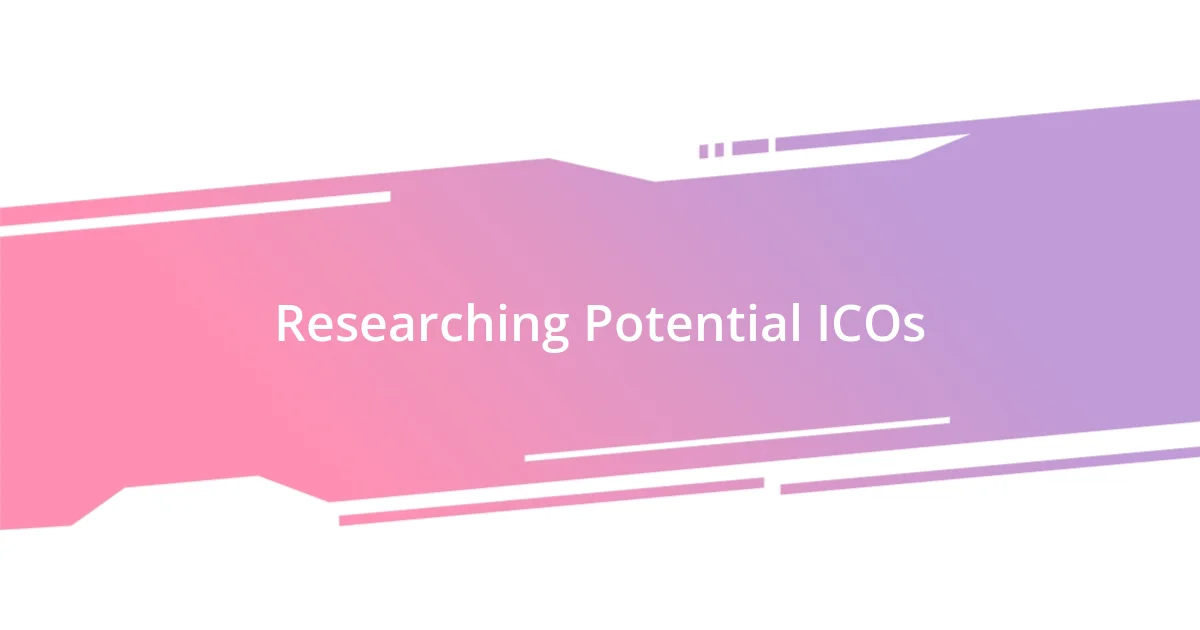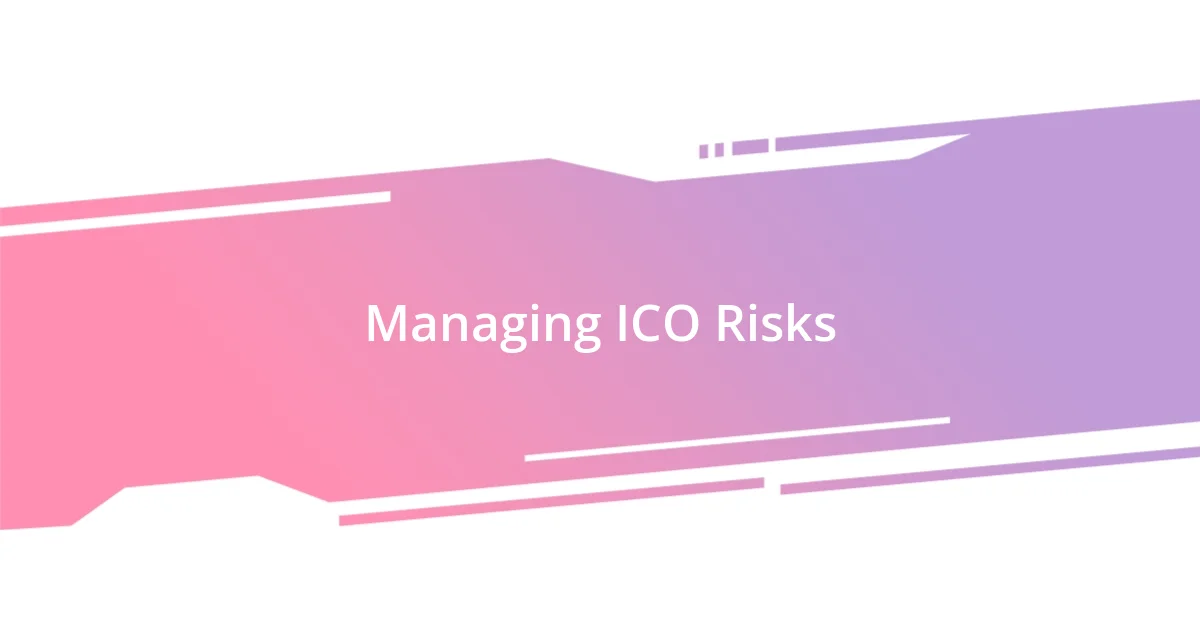Key takeaways:
- Critically assess ICOs by evaluating team credentials, use case, community presence, roadmap viability, and transparency to make informed investment decisions.
- Diversify investments across different ICO sectors and risk levels to mitigate losses and discover new opportunities in a volatile market.
- Continuously track ICO performance and adapt strategies based on market conditions, community insights, and ongoing education to enhance investment outcomes.

Understanding ICO Basics
When I first stumbled upon ICOs, or Initial Coin Offerings, it felt like entering a new frontier of investment. Essentially, an ICO is a method of fundraising through the sale of tokens to participants, who anticipate that these tokens will increase in value over time. Isn’t it exhilarating to think about being part of something so innovative?
Understanding the structure of ICOs is crucial. Tokens can represent various things, from a share in a project to access to a service. I can vividly remember my initial fear of being scammed, as I had heard stories of rogue ICOs disappearing with investors’ funds. It’s a harsh reality that not every ICO will succeed, which is why I learned to critically assess their whitepapers and the teams behind them. This lead me to ask: what are the real indicators of a project worth investing in?
Another key point I discovered was the importance of community engagement. Many ICOs rely heavily on their communities for support, and I remember participating in forums where enthusiasts dissected every aspect of potential projects. It made me realize the collective intelligence that often surfaces in these discussions, prompting me to consider how the community’s sentiment can influence a project’s success. Have you ever thought about how much of an investment decision is based on that intangible feeling of belonging to a like-minded group?

Researching Potential ICOs
Researching potential ICOs often feels like traversing a vast ocean of possibilities. My strategy was to start by diving deep into the whitepapers, which often read like a project’s blueprint. I recall unearthing hidden gems where the vision aligned perfectly with my own values. It’s like finding a rare pearl amidst all the chaos. The more I engaged with these documents, the better I understood how they articulated their technology and goals.
When assessing an ICO, I developed a framework to gauge its potential:
- Team Credentials: Evaluating the backgrounds of the founders and developers. A strong team with relevant experience can be a good indicator of a project’s viability.
- Use Case: Understanding the purpose of the token is essential. Does it serve a real need?
- Community Presence: I observed how active and engaged their social media presence was, as a buzzing community can reflect enthusiasm and trust.
- Roadmap Viability: Checking if the timeline of milestones seems realistic. Hasty timelines can often lead to unmet expectations.
- Transparency: Trustworthiness is key. Projects that provide regular updates and clear communication build confidence.
By examining these criteria, I felt more grounded in my investment decisions, which alleviated a lot of that initial anxiety I experienced with ICOs. It’s an empowering feeling to turn research into informed choices, enhancing my portfolio while riding the waves of this exhilarating market.

Diversifying My ICO Investments
Diversifying my ICO investments became a guiding principle in my journey. I vividly remember the panic I felt when a single project I had heavily invested in began to falter. That experience taught me a valuable lesson: relying too heavily on one investment can lead to significant losses. So, I started balancing my portfolio by investing in various sectors within the ICO landscape – some focused on smart contracts, others on decentralized finance, and a few on innovative solutions in healthcare. This approach not only mitigated risk but also allowed me to discover fascinating projects I wouldn’t have looked into otherwise. Have you thought about how diversification can provide a safety net in a volatile market?
In my case, I allocated a percentage of my portfolio to high-growth potential ICOs, while also dedicating funds to more established projects with a track record. It felt exhilarating to watch my portfolio grow as I embraced this dual approach. Having that blend of investments made me feel more secure, like a well-rounded meal that nourishes both risk appetite and cautiousness. Plus, there’s a thrill in venturing into new territories, meeting both seasoned veterans and enthusiastic newcomers at various community events. Have you ever noticed how engaging with a diverse group of investors can open your eyes to uncharted opportunities?
| Investment Focus | Risk Level |
|---|---|
| Established ICOs | Low |
| Emerging Projects | Medium to High |
| Sector Diversification | Varied |

Evaluating ICO Whitepapers
Evaluating whitepapers was truly an enlightening experience for me. Initially, I felt overwhelmed by the technical jargon, but I slowly learned to dissect them systematically. For instance, I remember one ICO that used a plethora of buzzwords without any clear explanation of its technology. That lack of clarity raised a red flag for me. Have you ever noticed how some projects are all talk and no depth?
As I honed my skills in evaluating these documents, I started making a checklist based on essential elements like the problem being addressed and the uniqueness of the solution. One project I encountered had a beautifully crafted whitepaper, but upon closer inspection, I found their solution was eerily similar to an existing one without any differentiating factor. It’s a sobering realization to think that an appealing presentation can sometimes mask a lack of true innovation. It makes me wonder—how often do we get lured in by flashy designs rather than substantive content?
Ultimately, understanding the whitepaper’s underlying principles helped me feel more confident about my investments. I vividly recall a moment when I discovered a potential project that aligned with my personal values, and the excitement was palpable. I felt as if I was on the brink of supporting something truly groundbreaking. Isn’t it fascinating how a well-constructed whitepaper can not only inform but also ignite passion and conviction within us as investors?

Managing ICO Risks
Managing ICO risks is a crucial aspect of my investment strategy. I remember the anxiety I felt during market fluctuations; it was as if I could feel my heartbeat matching the volatility of my portfolio. This heightened awareness pushed me to adopt rigorous assessment strategies, focusing not just on potential returns but also on potential pitfalls. It really made me question: how well do I truly understand the projects I’m investing in?
One of my tools against ICO risks was setting specific thresholds for loss tolerance. Early on, I had to learn this the hard way—I watched as my investment in a promising project dwindled because I didn’t act quickly enough. Now, I stick to my personalized stop-loss limits, which empower me to exit potentially sinking ships without losing sleep. Have you ever set such limits for yourself, and how did it change your approach?
Additionally, engaging with the community around these ICOs has become a cornerstone of my risk management approach. There was a point where I interacted with other investors online and discovered invaluable insights that I wouldn’t have stumbled upon alone. These discussions, filled with diverse perspectives, often highlight red flags or validations that help me navigate my choices with greater confidence. Isn’t it amazing how collaboration can sometimes illuminate paths we might overlook in isolation?

Tracking ICO Performance
Tracking the performance of my ICO investments became an essential part of my strategy. I distinctly remember the sense of urgency that washed over me when I realized I wasn’t keeping tabs on my assets regularly. One day, I opened my portfolio to find a project I thought was thriving had taken a nosedive. It made me question: how often do we truly pay attention to our holdings?
I turned to various tools for tracking, and one of my favorites is a dedicated crypto portfolio app. These tools allow me to monitor key metrics, like price changes and market sentiment, all in one place. I still recall the relief I felt when I noticed a sudden spike in one of my investments, prompting me to do additional research. Are you using any apps to stay updated on your investments, or are you relying on manual checks?
Engaging with platforms like Telegram and Reddit has also enriched my tracking process. I remember a time when a fellow investor shared a crucial update about an ICO’s progress, and I was able to act on it promptly, resulting in a favorable outcome. It showed me that real-time information is a game-changer. Isn’t it fascinating how community insights can sometimes guide our investment journeys in unexpected ways?

Adapting My Strategy Over Time
Adapting my strategy has been a continuous journey shaped by both successes and setbacks. I recall a time when I heavily invested in a project that seemed promising on paper but ultimately fell short. This experience taught me the importance of flexibility; now, I routinely evaluate and adjust my portfolio based on evolving market conditions and project developments. How often do you reflect on your initial judgments about a project as the situation changes?
As I gained more experience, I found that bolder moves sometimes lead to richer rewards. There was a pivotal moment when I saw a declining project, and instead of selling at a loss, I decided to dig deeper and invest further. This decision turned out to be a significant turning point, illustrating that patience—paired with timely adaptation—could yield impressive results. Have you ever found yourself pleasantly surprised by a project you decided to stick with against the odds?
Incorporating ongoing education into my strategy has greatly influenced how I adapt. I’ve joined webinars and read countless articles to stay informed about new trends and technologies. Just recently, I attended a workshop where experts discussed the potential of decentralized finance (DeFi). This exposure pushed me to diversify my holdings and ultimately adjust my portfolio to include promising DeFi projects. Learning never ceases; what new knowledge have you incorporated into your own investment strategies lately?














